
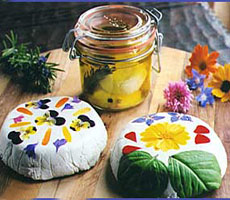 Beautiful Harley Farms goat cheeses, decorated with edible flowers and leaves. Beautiful Harley Farms goat cheeses, decorated with edible flowers and leaves.
|
STEPHANIE ZONIS focuses on good foods and the people who produce them. Click here to contact her.
|
|
August 2006
|
 |
Whey To Go ~ August 2006
-
Trends In Artisanal Cheese
-
Harley Farms Goat Dairy
My name is Stephanie Zonis, and welcome to Whey to Go! for August, 2006. Every month, we’ll delve into a new cheese-related subject, and I’ll offer a recommendation of a cheese I love.
What’s Next: Notes From The 2006 Annual Conference Of The American Cheese Society
While it’s true that an entity called the “American Cheese Society” sounds like a subdivision of Kraft, it is anything but. In truth, the ACS is an organization devoted to cheese, butters, and yogurts of superior quality—and when I say cheese, I mean real cheese, not that processed “cheese food” garbage (just what is “cheese food,” anyhow?). Each year, in July, the ACS holds an annual conference in a different city. Freshly returned from Portland, Oregon, this year’s host city, I offer a few insights on trends and what’s happening in the world of cheese. This year, the key word seemed to be “more.”
- More Cheesemakers and More Cheeses. The ACS is a growing organization, given the number of enthusiasts, retailers, distributors, etc. who have joined the ranks over the years. But I’m also seeing far more cheesemakers than I once did. Most are small-scale and face a steep learning curve, but they are, without exception, enthusiastic and proud of their products. Many have great stories behind them, and not a few make exceptional cheeses. The annual conference is also a prestigious competition. Want proof of that claim of “more cheeses?” There were a total of 951 entries for judging this year, up from 700+ the last time I attended an ACS conference, which was in 2004.
- More Original and Flavored Cheeses. Cheesemakers today are not just sticking to producing Cheddar and Swiss. While those old favorites won’t go out of style anytime soon (thankfully), you’re at least as likely to find an entirely new
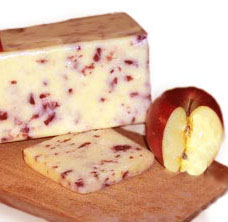 cheese from an artisanal cheesemaker as you are a classic like Gouda. Many of these new cheeses are based on formulations that already exist, but cheesemakers can alter anything from the type of milk used to the cultures added to the aging process and come up with something very different; just a slight change in climate from the place where a cheese was originally made, for instance, can lead to noticeable alterations in flavor, texture, or color. Even when popular cheeses are made nowadays, they’re apt to be flavored with something. I saw multiple cheeses spiked with jalapeño or other “hot” flavors, a Cranberry Cheddar (photo above left), a Strawberry Quark, and an Anise Lavender Wheel; other cheeses were smoked (lots of those) or flavored with garlic, cumin, caraway, honey, or vegetables. cheese from an artisanal cheesemaker as you are a classic like Gouda. Many of these new cheeses are based on formulations that already exist, but cheesemakers can alter anything from the type of milk used to the cultures added to the aging process and come up with something very different; just a slight change in climate from the place where a cheese was originally made, for instance, can lead to noticeable alterations in flavor, texture, or color. Even when popular cheeses are made nowadays, they’re apt to be flavored with something. I saw multiple cheeses spiked with jalapeño or other “hot” flavors, a Cranberry Cheddar (photo above left), a Strawberry Quark, and an Anise Lavender Wheel; other cheeses were smoked (lots of those) or flavored with garlic, cumin, caraway, honey, or vegetables.
- More Sheep’s and Goats’ Milk Cheeses. Cows’ milk cheeses continue to rule
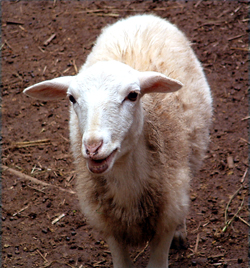 the roost in the U.S., as far as popularity, number and variety made, and availability. But cheeses made from sheep’s and goats’ milk have increased impressively in number as well as type. Sheep and goats, though they give substantially less milk than cows, are smaller, easier-to-handle livestock, who require less land than do cows. All of these are assets for wannabe cheese producers who don’t have massive pasture acreage, or a lot of help. And consumers are gradually waking up to the idea that cheeses made from the milk of these animals can really be delicious. the roost in the U.S., as far as popularity, number and variety made, and availability. But cheeses made from sheep’s and goats’ milk have increased impressively in number as well as type. Sheep and goats, though they give substantially less milk than cows, are smaller, easier-to-handle livestock, who require less land than do cows. All of these are assets for wannabe cheese producers who don’t have massive pasture acreage, or a lot of help. And consumers are gradually waking up to the idea that cheeses made from the milk of these animals can really be delicious.
- More Specialty Cheese Retailers. I’ve started seeing this trend in the bigger cities, but I expect it to gradually filter down to upscale suburbs. These establishments are often quite small, but they’ll have a beautifully-chosen, albeit modest, selection of some fabulous cheeses. The proprietors know about cheeses and how to care for them; you won’t find shrink-wrapped, pre-cut wedges of anything in these cheese boutiques. Occasionally located within a larger wine store (well, that’ll make the wine pairing an easy matter, won’t it?), these are retailers worth seeking out.
- More Enthusiasm for Raw Milk Cheeses. Cheeses made from unpasteurized (or “raw”) milk, while still illegal in many countries and hampered by antiquated legislation in the U.S., have found increasing favor among cheese enthusiasts and retailers in recent years. The current U.S. regulations were written in 1949, believe it or not, and require a 60-day aging process before any cheese made with unpasteurized milk can be sold in this country. Some people don’t consider that a long-enough aging period to destroy harmful pathogens, and would like to ban raw milk cheeses outright. Yet the Center for Disease Control’s own data suggest that more people contract food-borne illnesses from vegetables than from cheeses made with raw milk. Additionally, it’s important to note that pasteurized milk cheeses can easily become contaminated with pathogens through improper handling, transportation, or storage. Do I eat raw milk cheeses? Every chance I get. By the way, if you insist on genuine Parmigiano Reggiano when you buy Parmesan, which you should, you eat raw milk cheese, too (but well-aged).
- More Artisanal Yogurts and Butters. I understand that the term “artisanal” is
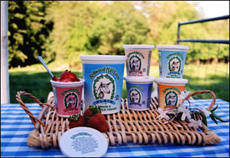 sorely overused these days, but I can think of no phrase more appropriate. These are special yogurts and butters. While some are produced in larger quantities than others, care is taken with all of them, and the difference is evident in the taste. These are butters to make you dream, and yogurts to tempt even those least likely to consume them. Sheep’s and goat’s milk yogurts were especially prevalent this year. Yogurts and butters comprise a small but growing percentage of the dairy products found at this conference. Photo: RedwoodHill’s award-winning goat’s milk yogurts. sorely overused these days, but I can think of no phrase more appropriate. These are special yogurts and butters. While some are produced in larger quantities than others, care is taken with all of them, and the difference is evident in the taste. These are butters to make you dream, and yogurts to tempt even those least likely to consume them. Sheep’s and goat’s milk yogurts were especially prevalent this year. Yogurts and butters comprise a small but growing percentage of the dairy products found at this conference. Photo: RedwoodHill’s award-winning goat’s milk yogurts.
- More Emphasis on the Animals. It’s wonderful to see how many cheesemakers are concerned with the health and comfort of their animals. True, it’s in the best interest of these producers, as content and healthy cows, sheep, and goats will give more and better milk for a longer time. But this crucial aspect of any dairy product is a much bigger and more publicized issue than it once was, and it’s gratifying to know that some cheesemakers really care about their flocks and do their best for them.
I hope I’ll be forgiven if I put in a small plug for the ACS here. This was my third conference, and they continue to improve. Although the level of organization is still not all it could be, I always meet great people at the conference and I’ve never failed to get into at least one terrific seminar (and it’s usually more than one). There are special tours arranged for conference participants, too. The highlight is Saturday evening’s Festival of Cheeses. Everyone who submits a product for judging must also submit some for the Festival (remember, there were a total of 951 products submitted for judging this year, so you do the math). The result is usually a large hotel function room with table upon table of cheeses, where you can try as many products as you like over the course of some 4 or 5 hours. Wines, beers, and nonalcoholic beverages are also offered, as are accoutrements to cheeses, including fresh and dried fruit, breads, crackers, pates, and more. You must be a member of ACS to attend the conference, but you need not be a food professional to join. Next year’s conference is in Vermont—just something to think about!
Company Of The Month: Harley Farms Goat Dairy
Although they’ve been making cheese for 14 years, I first ran across the products of Harley Farms Goat Dairy this past winter when I was in San Francisco. Goat cheese is a tricky proposition, and can taste “goaty,” for lack of a better adjective, if the milk isn’t processed promptly or if any of several other variables are just a bit off—but you won’t find that here. What you will discover are fresh-tasting, fresh (as opposed to aged) goat cheeses, in rounds decorated beautifully with edible blooms or topped with sweet or savory garnishes that go with the cheese perfectly. You’ll get a mild flavor from the cheese (though you’ll know it’s not made from cow’s milk) plus a combination of other complementary flavors all in one, so these cheeses are ideal as ready-made appetizers or snacks.
While Harley Farms Goat Dairy took two prizes at the recent ACS Conference (a First 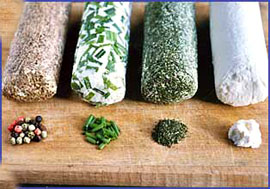 Place for their cleverly-named “Van Goat” and a Third Place for their Cranberry Walnut), my favorite remains the Apricot Pistachio Torte, which includes a layer of chopped pistachio nuts and is topped with dried apricots. If you’re in the mood for a savory goat cheese, try the Tomato Basil Torte or one of the Chevre Logs (pepper or dill, perhaps). Harley Farms Goat Dairy is based in California (they do farm tours and have a shop there), but fear not if you live far off, as you can also order their cheeses online. Surf over to www.harleyfarms.com; read more about the dairy, the goats, and the guard llama; and see if you can resist placing an order! Place for their cleverly-named “Van Goat” and a Third Place for their Cranberry Walnut), my favorite remains the Apricot Pistachio Torte, which includes a layer of chopped pistachio nuts and is topped with dried apricots. If you’re in the mood for a savory goat cheese, try the Tomato Basil Torte or one of the Chevre Logs (pepper or dill, perhaps). Harley Farms Goat Dairy is based in California (they do farm tours and have a shop there), but fear not if you live far off, as you can also order their cheeses online. Surf over to www.harleyfarms.com; read more about the dairy, the goats, and the guard llama; and see if you can resist placing an order!
Lifestyle Direct, Inc. All rights reserved. Images are the copyright of their respective owners. 
|




 Beautiful Harley Farms goat cheeses, decorated with edible flowers and leaves.
Beautiful Harley Farms goat cheeses, decorated with edible flowers and leaves.  cheese from an artisanal cheesemaker as you are a classic like Gouda. Many of these new cheeses are based on formulations that already exist, but cheesemakers can alter anything from the type of milk used to the cultures added to the aging process and come up with something very different; just a slight change in climate from the place where a cheese was originally made, for instance, can lead to noticeable alterations in flavor, texture, or color. Even when popular cheeses are made nowadays, they’re apt to be flavored with something. I saw multiple cheeses spiked with jalapeño or other “hot” flavors, a Cranberry Cheddar (photo above left), a Strawberry Quark, and an Anise Lavender Wheel; other cheeses were smoked (lots of those) or flavored with garlic, cumin, caraway, honey, or vegetables.
cheese from an artisanal cheesemaker as you are a classic like Gouda. Many of these new cheeses are based on formulations that already exist, but cheesemakers can alter anything from the type of milk used to the cultures added to the aging process and come up with something very different; just a slight change in climate from the place where a cheese was originally made, for instance, can lead to noticeable alterations in flavor, texture, or color. Even when popular cheeses are made nowadays, they’re apt to be flavored with something. I saw multiple cheeses spiked with jalapeño or other “hot” flavors, a Cranberry Cheddar (photo above left), a Strawberry Quark, and an Anise Lavender Wheel; other cheeses were smoked (lots of those) or flavored with garlic, cumin, caraway, honey, or vegetables.  the roost in the U.S., as far as popularity, number and variety made, and availability. But cheeses made from sheep’s and goats’ milk have increased impressively in number as well as type. Sheep and goats, though they give substantially less milk than cows, are smaller, easier-to-handle livestock, who require less land than do cows. All of these are assets for wannabe cheese producers who don’t have massive pasture acreage, or a lot of help. And consumers are gradually waking up to the idea that cheeses made from the milk of these animals can really be delicious.
the roost in the U.S., as far as popularity, number and variety made, and availability. But cheeses made from sheep’s and goats’ milk have increased impressively in number as well as type. Sheep and goats, though they give substantially less milk than cows, are smaller, easier-to-handle livestock, who require less land than do cows. All of these are assets for wannabe cheese producers who don’t have massive pasture acreage, or a lot of help. And consumers are gradually waking up to the idea that cheeses made from the milk of these animals can really be delicious. sorely overused these days, but I can think of no phrase more appropriate. These are special yogurts and butters. While some are produced in larger quantities than others, care is taken with all of them, and the difference is evident in the taste. These are butters to make you dream, and yogurts to tempt even those least likely to consume them. Sheep’s and goat’s milk yogurts were especially prevalent this year. Yogurts and butters comprise a small but growing percentage of the dairy products found at this conference.
sorely overused these days, but I can think of no phrase more appropriate. These are special yogurts and butters. While some are produced in larger quantities than others, care is taken with all of them, and the difference is evident in the taste. These are butters to make you dream, and yogurts to tempt even those least likely to consume them. Sheep’s and goat’s milk yogurts were especially prevalent this year. Yogurts and butters comprise a small but growing percentage of the dairy products found at this conference.  Place for their cleverly-named “Van Goat” and a Third Place for their Cranberry Walnut), my favorite remains the Apricot Pistachio Torte, which includes a layer of chopped pistachio nuts and is topped with dried apricots. If you’re in the mood for a savory goat cheese, try the Tomato Basil Torte or one of the Chevre Logs (pepper or dill, perhaps). Harley Farms Goat Dairy is based in California (they do farm tours and have a shop there), but fear not if you live far off, as you can also order their cheeses online. Surf over to
Place for their cleverly-named “Van Goat” and a Third Place for their Cranberry Walnut), my favorite remains the Apricot Pistachio Torte, which includes a layer of chopped pistachio nuts and is topped with dried apricots. If you’re in the mood for a savory goat cheese, try the Tomato Basil Torte or one of the Chevre Logs (pepper or dill, perhaps). Harley Farms Goat Dairy is based in California (they do farm tours and have a shop there), but fear not if you live far off, as you can also order their cheeses online. Surf over to